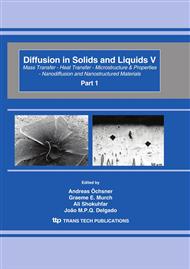p.1109
p.1116
p.1122
p.1127
p.1133
p.1140
p.1146
p.1152
p.1160
Evolution of Interdiffused Gaussian-Shape Nanolayer in Au-Si(111) System at Ambient Condition
Abstract:
Evolution of interdiffused Gaussian-shape nanolayer of Au-Si, formed due to diffusion of Au into Si(111) substrate at ambient conditions, depends strongly on the Si surface pretreatment/passivation conditions. Negligible diffusion in the Au-OSi(111) sample, confirms the strong barrier action of the oxide-layer against diffusion, while large diffusion in the Au-HSi(111) sample compared to that in the Au-BrSi(111) sample suggests that the H-passivated Si(111) surface is more stable. This nature of the Au-Si(111) system is qualitatively similar to that of the Au-Si(001) system but it differs quantitatively. The size, electronegativity and bond-energy of the passivating elements and the number of dangling bonds on the Si surface influence the instability of the Si surface. This instability, parameterized by growth-time of oxide layer alone, can be utilized to tune the amount of diffusion into the sub-surface Si region. The distribution of growth-time and fractional passivated area, which are related to the improper Si surface passivation, are against such control and needs perfection.
Info:
Periodical:
Pages:
1133-1139
Citation:
Online since:
April 2010
Price:
Сopyright:
© 2010 Trans Tech Publications Ltd. All Rights Reserved
Share:
Citation:


